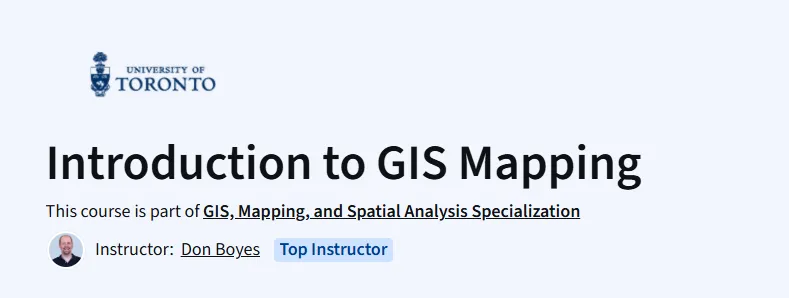What will you learn in Introduction to GIS Mapping Course
Understand the fundamentals of Geographic Information Systems (GIS).
Create basic GIS maps using ArcGIS Online.
Explore spatial data, layers, and geographic visualization.
Use GIS tools for analysis and storytelling with maps.
Program Overview
Module 1: What Is GIS?
⏱️ 1 week
Topics: History and use of GIS, spatial thinking, GIS applications.
Hands-on: Explore map interfaces and GIS software tools.
Module 2: Layers and Attributes
⏱️ 1 week
Topics: Map layers, feature attributes, and coordinate systems.
Hands-on: Practice with map symbols, layer manipulation, and attribute tables.
Module 3: GIS Mapping and Visualization
⏱️ 1 week
Topics: Map design principles, thematic mapping, color schemes.
Hands-on: Create your own maps using ArcGIS Online.
Module 4: Story Maps and Analysis
⏱️ 1 week
Topics: Storytelling with maps, spatial analysis tools.
Hands-on: Build a GIS story map project using real-world data.
Get certificate
Job Outlook
GIS skills are in demand in fields such as urban planning, environmental science, public health, logistics, and disaster management.
GIS analysts and technicians earn between $55,000–$85,000, with growing opportunities in smart cities and climate data modeling.
Entry-level friendly with clear pathways to advanced geospatial roles.
Specification: Introduction to GIS Mapping
|
FAQs
- No prior GIS or mapping experience is required.
- Basic computer literacy is sufficient to follow the lessons.
- The course introduces GIS tools and mapping concepts step-by-step.
- Learners gradually build confidence in handling geospatial data.
- Beginners can start exploring GIS without feeling overwhelmed.
- The course provides guided exercises using common GIS platforms.
- Learners work with geospatial datasets to create maps and visualizations.
- Practical labs reinforce theoretical knowledge.
- Step-by-step tasks show how to analyze and present geographic data.
- Skills gained prepare learners to use GIS tools in academic or professional projects.
- Learners explore applications in urban planning, environmental monitoring, and disaster management.
- Case studies show how GIS supports decision-making in government and business.
- Examples highlight the role of GIS in transportation, agriculture, and public health.
- Practical exercises connect GIS concepts to real-world scenarios.
- Skills are relevant across multiple industries where spatial analysis is important.
- GIS is widely used in environmental research, urban development, and policy-making.
- Knowledge gained strengthens applications for data analyst, GIS technician, or research roles.
- Hands-on map-making and spatial analysis demonstrate practical ability.
- Skills are valued in industries from engineering to conservation.
- Completion signals readiness to contribute to GIS projects or pursue advanced GIS training.
- Estimated completion is 3–5 weeks at a part-time pace.
- Weekly effort of 3–5 hours is generally sufficient for lectures and exercises.
- Regular practice with GIS software reinforces technical confidence.
- Additional time may be required to explore datasets or create custom maps.
- Consistent study ensures learners develop both conceptual and hands-on GIS skills.





